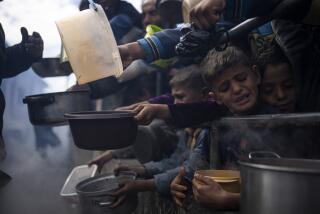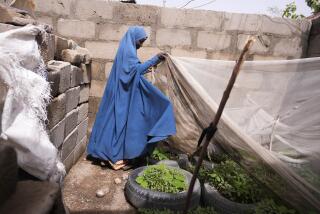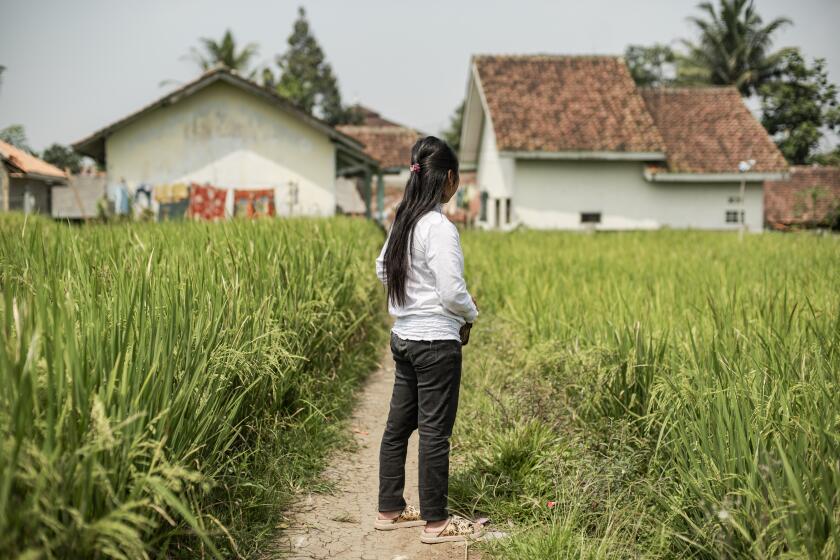U.N. declares famine in southern Somalia
Reporting from Johannesburg, South Africa — For months, people have been trudging out of the desert, leaving their dead children behind and carrying those who have managed to survive. On Wednesday, the horror of hunger and death unfolding in the Horn of Africa officially got a name: famine.
It’s actually a very technical term, unless you’re one of those walking for weeks in a last-ditch hope to save your family.
For the United Nations to declare a famine, as it did at a news conference in Nairobi, Kenya, the rate of child malnutrition must be at 30% or higher, daily deaths at two per 10,000 people and people not have access to food and other basic necessities.
According to UNICEF, the U.N. agency that focuses on children, the child malnutrition rate in southern Somalia has doubled in a single month; in some places it has reached 55% and infant deaths have increased to six a day.
Yet the global response has been dismal. An appeal late last year for $535 million to address the need is still more than $250 million short. Officials hope the famine declaration will help focus global attention on the Horn of Africa.
Across Somalia, about 3.7 million people, half the population, are facing starvation, with an estimated 2.8 million of them in the south. The agency says an additional 6.3 million in other Horn of Africa countries are affected by hunger.
It’s the worst hunger crisis in Africa in 20 years, said Rozanne Chorlton, UNICEF’s representative to Somalia. The last time things were this dire in Africa was 1991. Then, as now, the crisis was in Somalia.
The famine declaration Wednesday formally covered two regions of southern Somalia, Bakool and Lower Shabelle, where farmers’ crops have failed and their livestock died. But in coming months, neighboring regions will inevitably fall into famine too, said Mark Bowden, the U.N. humanitarian coordinator for Somalia.
U.N. and nongovernmental agencies are appealing for $300 million in the next two months to increase their operations in the worst-affected areas.
If it seems extraordinary that millions of Africans can be facing starvation in 2011, despite the focus of a raft of humanitarian agencies and their early-warning networks, it is, Bowden said.
Part of the problem is that many donors had written off Somalia as too hard, he said in a telephone interview. Aid agencies must grapple with a long-running civil conflict and Somalia’s extremist Shabab militia, which controls much of the south, the region that faces the worst hunger.
“We have good warning systems, but we don’t always listen to them, particularly if we put some countries in the too-difficult-to-deal-with basket,” Bowden said.
Two decades with no government and the failure of successive efforts to restore peace have left donors cynical. The country’s global reputation for piracy and mayhem has done it no favors.
The 1991 Somalia famine occurred after civil war destroyed agriculture and clan warlords hijacked humanitarian aid, leading to the U.S.-led Operation Restore Hope. That resulted in bloody fighting with militias in Mogadishu portrayed in the book and film “Black Hawk Down.”
But Bowden, who recently met Somali refugees walking to Ethiopia, said the problem today is mainly one of successive drought, compounded by global warming.
“They are victims of drought. They are also victims of climate change. They’re people who have lost everything after years of successive drought.”
The situation is complicated by the Shabab, which in the past has imposed informal taxes on humanitarian agencies, limited their access and demanded that they send female staff home. The World Food Program withdrew early last year from areas controlled by the Shabab because of security threats and unacceptable working conditions. It recently announced it would resume work there if conditions allowed.
Aid agencies have been negotiating access with local leaders, but security remains uncertain.
“We need predictability,” UNICEF’s Chorlton said in a telephone interview. “The important thing is that those who are there [in Somalia] should be able to act unhindered to deliver the services to children and families that are so desperately needed.”
UNICEF has doubled its food, health and water programs in Somalia, she said.
“Somalis have always helped each other to cope in times of crisis, and they have been incredibly resilient over the years. I think what has not been quantified is that people’s resistance has been so undermined over the last year, it’s no longer adequate to the task,” she said. “The issue is now we need donors to massively increase their contribution.”
More to Read
Sign up for Essential California
The most important California stories and recommendations in your inbox every morning.
You may occasionally receive promotional content from the Los Angeles Times.










